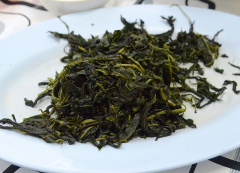Jutean cuisine
Jutean Cuisine has, despite the relatively small size of the island, huge regional varieties, with South Jute being, owing to the different climate, the most distinct one.
In general, the more populated coastal regions are largely pescetarian and appreciate the versatility of the coconut. Dishes are traditionally dominated by fresh fish, fruits and vegetables, with little grains or seeds, though these later became more popular as contact was established with other regions inland and abroad.
In the former, fish is less common, but leaves of the jute plant, and bananas are staples everywhere aside from the mountainous Klambari-speaking region in the east, where they're not really common. Animal husbandry is more important there, and the only communities with hunting traditions can be found there, with meat consumption being hardly known on the settlements lining the shore for the longest period of time.
Traditional Coastal Jutean
This cuisine is the predominant one in the regions which historically have been populated by the Coastal Juteans (sometimes incorrectly shortened to Juteans), which includes mostly the central and southern coasts, as well as the part of the interior neighboring these coasts, where native Coastal Jutean speakers can be found up onto 30 km inland.
Main dishes
Side dishes
Jute leaves
The national food of Jute and Coastal Juteans in particular, the jute leaves aren't just sharing their name with the nation, they are seen as a symbol of it and the Jute plant is the national plant of Jute. Already having been grown on the central and southern coasts for thousands of years, it's now seen all over the island.
Tender and full of taste, which foreigners have compared to spinach, it's also choke full of nutrients, including beta-carotene, iron, calcium and Vitamin C as well as E. It's also rich in antioxidants, all of which has made it earn its place in a healthy diet as well as preventive and curative medicine, where it has been used for example against fever, colds and cystitis. It also can help prevent chronic diseases and cancer, or cure a lack of appetite or fatigue. It's also said to be the secret of the often fair and wrinkle-free skin Juteans are renowned for.
In Jutean cuisine, it can be a simple cooked side dish, sometimes paired with either plantains or sometimes rice, or be made into a simple, thick soup. Other culinary uses include a thickener for all kinds of soups and stews as well as sauces. Sometimes it's also drank as a hot beverage similar to tea. Try it in the Saan a havan bar at the beach of Southern Jute City, famous for adding a special spice mixture to it. Or order a warm Jute salad in Ohajun, located in the northeastern edge of the city.
Desserts
Jute City
River Jutean
Main dishes
Side dishes
Desserts
Klambari
Main dishes
Side dishes
Black rice The traditional staple of the more mountainous part of the island in the Southeast, home to the Klambari speaking population. Possibly cultivated for even longer than Jute leaves, they are the favorite side dish of the region, but also have started to become popular in other corners of Jute, notably in cities and the valleys close to the mountain range.
Similar to brown rice, but with an even stronger nutty, almost a bit fruity taste and a soft, but chewy texture, it's a grain to either be adored or despised. Though whoever chooses to stay away from it will also miss out on the high amounts of vitamin B1, B3, B6, E, manganese, phosphorus, iron, zinc, fiber and essential fatty acids. It also includes antioxidants in an amount that might even exceed that of blueberries.
Like other kinds of rice, it's usually cooked or steamed and then served as a simple side dish, however it can also be made into bread, pudding or, as a breakfast or simple evening meal, porridge. Sweets also often contain black rice, which then all have the characteristic deep purple color black rice turns to when cooked. Central Ambato has a lot of small snackbars selling a great variety of dishes, always with black rice on the side or mixed with other fresh, local ingredients.
